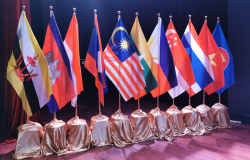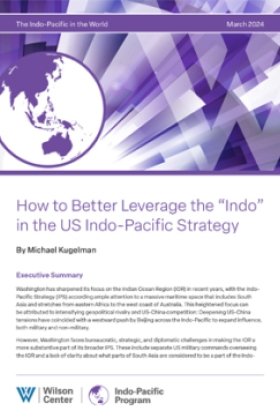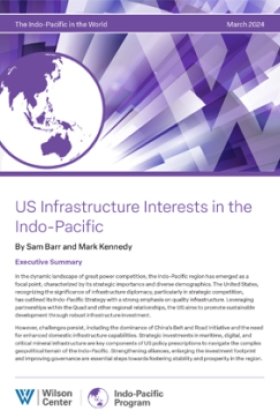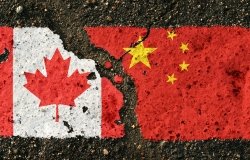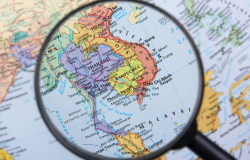Strategic Transitions in South Asia
Walter Andersen, Johns Hopkins University School of Advanced International Studies; Stephen Blank, U.S. Army War College; Rafiq Dossani, Stanford University Asia-Pacific Research Center; Rodney Jones, Policy Architects International; Polly Nayak, Independent Consultant and Retired U.S. Intelligence Officer; Haider Nizamani, University of British Columbia; Maria Sultan, University of Bradford, South Asian Strategic Stability Unit
Overview
An Asia Program Event
Cosponsored with the South Asian Strategic Stability Unit, University of Bradford (UK)
Despite reduced tensions between India and Pakistan over the past several years, South Asia remains one of the world's most volatile regions. On February 2, the Asia Program, in partnership with the University of Bradford's South Asian Strategic Stability Unit, hosted a half-day conference to assess the significance of recent strategic developments in South Asia since the terror attacks on New York and Washington more than four years ago.
The remarkable transformation in relations between India and the United States, symbolized by the announcement last summer of an agreement providing for cooperation between the two in the field of peaceful nuclear energy, figured heavily in discussions throughout the day. The new sense of shared interests binding India and America should not be viewed merely as a bilateral matter, declared Bradford University's Maria Sultan in a scene-setter opening the conference. To the contrary, it holds implications for other countries in the region, most notably Pakistan and China, and may represent "a significant paradigm shift" in regional and international security.
Several conference speakers asked how Pakistani interests would be impacted by the new comity between Washington and New Delhi. SAIS's Walter Andersen argued that Islamabad has little to fear from closer U.S.-Indian ties. Washington, Andersen noted, has at last stopped "clubbing" the two South Asian rivals together – that is, American decision makers now shape U.S. policy toward each largely independently of U.S. policy toward the other. Moreover, Andersen added, Washington has finally come to consider India and Pakistan as strategically important in themselves, and not merely derivative of some
larger policy goal, such as containment of the USSR. This is good news for Pakistan, since it suggests that Washington has accepted the desirability of a stable long-term relationship with Islamabad, irrespective of other global policy objectives.
Veteran intelligence officer (now retired) Polly Nayak conceded that Pakistan might, under some circumstances, feel threatened by a strengthened U.S.-India partnership – if, for instance, tensions between India and Pakistan were to escalate. But she devoted most of her presentation to outlining the conditions under which the further development of U.S.-Indian ties might not cause much anxiety in Pakistan. Islamabad would be fairly relaxed about a close U.S.-Indian partnership, she suggested, if Pakistan –
a) continues to receive aid, military equipment, high-level contacts,
and support in international forums from the United States;
b) does well economically;
c) is able to maintain stability in the domestic political arena; and
d) sees no added security threat from India as a result of New Delhi's
enhanced American connection.
Rodney Jones offered a more somber tone by warning that it would be a dangerous strategic error if Washington permitted its newfound partnership with India to marginalize longstanding U.S. ties with Pakistan. Jones cautioned against exaggerated expectations for U.S.-India relations. India's location is somewhat off the beaten geopolitical track, he asserted, meaning that it is less well positioned than, say, Pakistan to serve key U.S.
strategic requirements. American hopes about India playing a "counterbalancing role" with respect to China "may be wishful thinking." Perhaps most alarmingly, American arms transfers to India could impair Pakistan's confidence in the security of its nuclear deterrent, thereby stimulating Pakistani moves that could lower the nuclear threshold in the region and make a nuclear war in South Asia more likely. More happily, Jones (and other speakers) raised the possibility that a close U.S. relationship with India might help India and Pakistan at long last resolve the Kashmir problem that has so bitterly divided them ever since the creation of the two states in 1947.
Haider Nizamani of the University of British Columbia echoed some of the cautions offered by Jones, urging Washington to be more active in helping India and Pakistan resolve their deep-seated differences and advising the United States to broaden its vision of Pakistan. Islamabad must not be seen merely as an ally of convenience in the war against terror, he argued. Pakistan is a key country that will play a significant role, for good or ill, on many of the political, security, economic, and non-proliferation issues that will dominate the coming quarter century. Pakistan can make itself a more attractive partner for the United States, he added, if it strengthens democracy at home and develops a less reactive diplomacy.
After several presentations focusing on Pakistan, Rafiq Dossani of Stanford University sought to shift the discussion by exploring Indian nationalism and what he called the "Indian nation-building project." Dossani summarized the strategy employed by India's first generation of leaders to unify the country as one of centralized control in both the economic and political realms. In return for these "often stultifying" controls, the nation was kept relatively free of political, ethnic, religious, and class strife. Although India has achieved considerable economic growth over the past 15 years, it is likely to continue its inward orientation, leading to a diplomacy that will be reactive and accommodating. Pakistan, Dossani concluded, has little to worry about from an India preoccupied with domestic stability and economic growth.
The U.S. Army War College's Stephen Blank sought to expand the discussion beyond a narrowly defined concept of South Asia and argued that energy security must be seen as a central element of any discussion of strategic transitions in the region. The quest for reliable energy supplies, he declared, is reshaping international relations in Asia and obliterating distinctions among regions in favor of a much more dense and complex cross-cutting network of continental relationships among leading actors such as India, China, Japan, and Russia. Washington, he warned, cannot afford to remain "complacent and adrift as has been the case up till now" with regard to energy.
Drafted by Robert M. Hathaway, Director, Asia Program, Ph: (202) 691-4020
Hosted By

Indo-Pacific Program
The Indo-Pacific Program promotes policy debate and intellectual discussions on US interests in the Asia-Pacific as well as political, economic, security, and social issues relating to the world’s most populous and economically dynamic region. Read more
Thank you for your interest in this event. Please send any feedback or questions to our Events staff.

